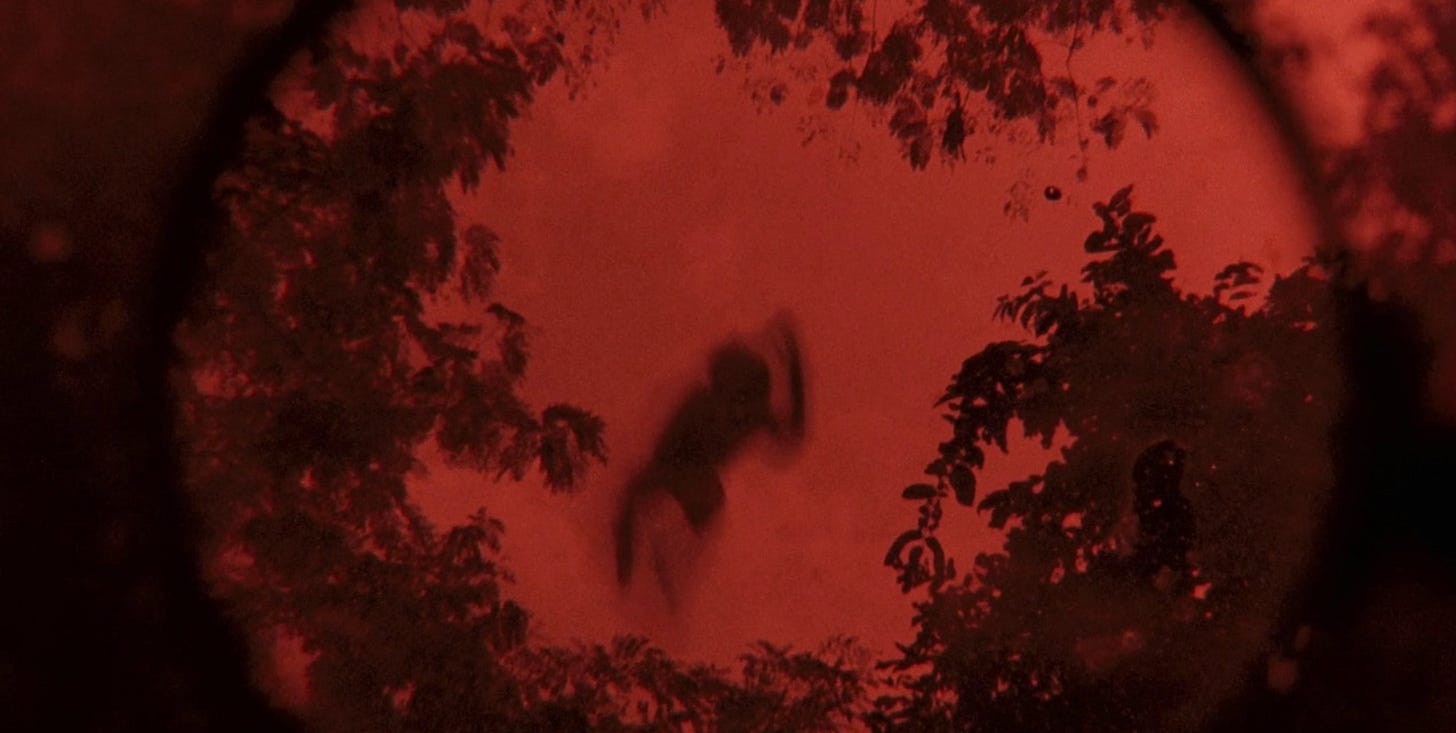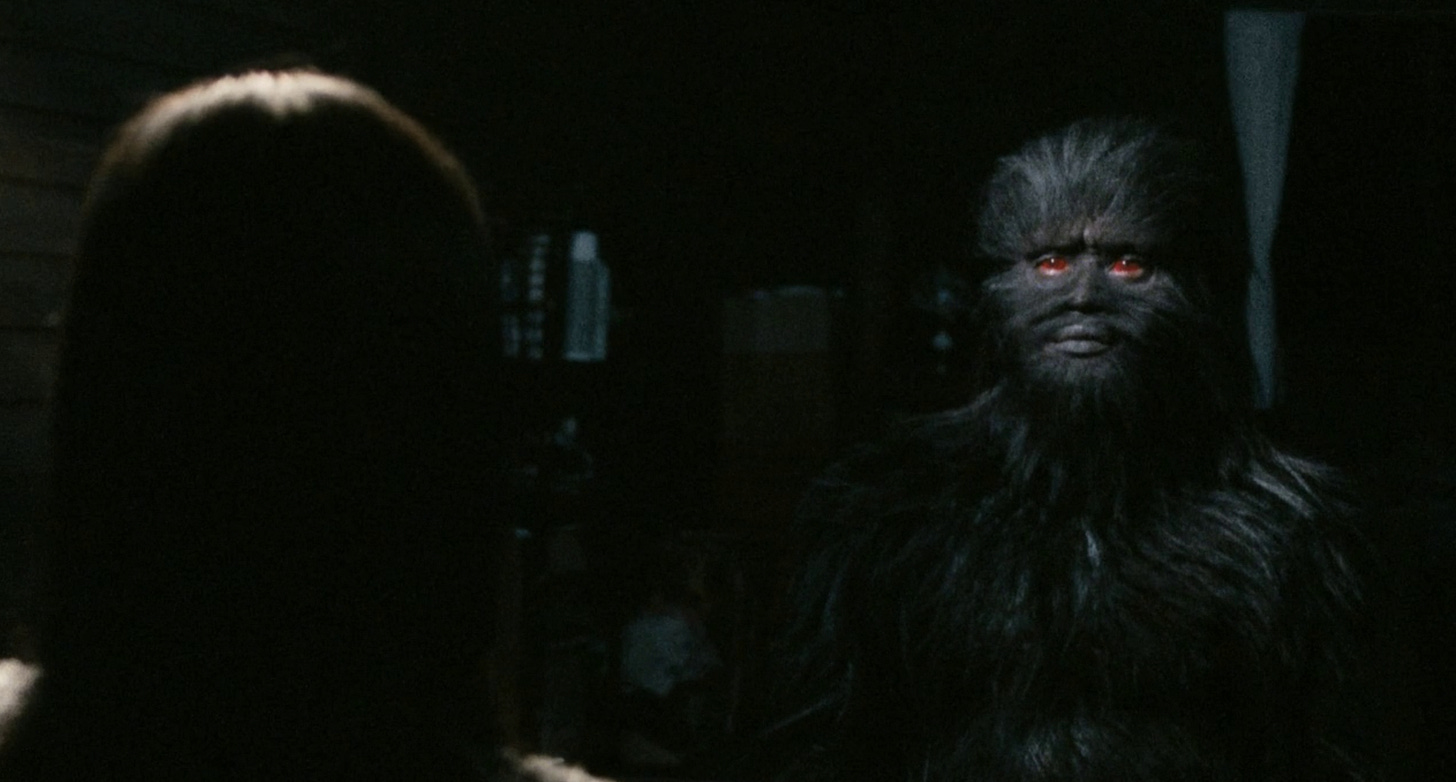From a lecture at the Southeast Asian Conference for Comparative Literature for 2023, hosted in Hanoi, Vietnam.
Spectators of their own impermanence, the figures in Apichatpong Weerasethakul’s Uncle Boonmee Who Can Recall His Past Lives (2010) move through a world whose most casual gestures are in quiet conversation with eternity. “All conditioned things are impermanent,” teaches the Dhammapada (v. 277), and that very line might well have been pencilled into the shooting script: it governs the way wooden spoons clack against enamel bowls, the way mist unrolls over tamarind leaves, the way a ghost sits down to dinner without asking whether anyone minds.
The film begins with an ox that has slipped its tether at dusk. Nothing terrible happens (no guns, no slaughter—it’s so far from obviously a “cold open”) but the sequence establishes the moral vibration of everything that follows. The farmer who retrieves the animal is framed in silhouette, and when he strokes the beast’s flank the gesture feels liturgical, as though he were laying a hand on a fellow pilgrim. From the opening frames we are in a universe where skin, hide, bark and cloud share a single frequency of being. In other Buddhist scripture, the Udāna speaks of “the unborn, unbecome, unmade, [and] unconditioned”; in Weerasethakul’s cinema that dimension flickers around the edges of the everyday. It’s an after-image visible only if we resist the urge to blink.
I remember first encountering Boonmee as a JPEG: a porch lit by one naked bulb, four people eating rice, and—standing just outside the light—a furred creature with eyes like pairings from a butcher’s knife. The photograph had the stillness of a Nam June Paik installation; it resisted narration. Cannes jurors in 2010 handed Weerasethakul the Palme d’Or over the likes of Mike Leigh and Abbas Kiarostami precisely because the picture did not behave like a narrative: it behaved like weather. Tim Burton, who chaired the jury, later remarked that the film made him “dream with his eyes open.” That line is pure Apichatpong. Dreams here are not escapes from reality; they are one of reality’s grammatical moods.

To admire his work is to watch the figurative turn relentlessly literal. In the collage-doc Mysterious Object at Noon (2000) the ghostly boy in the wheelchair never meets the people who invoke him; by Tropical Malady (2004) the phantom tiger sniffs the soldier’s footprints but remains a proposition made of night; by Uncle Boonmee (2010) the supernatural has claimed a seat at the family table. The director was only forty when he accepted the Palme, yet the prize felt like the culmination of a logic he had been patiently tightening for a decade—the moment animism, folklore and Mahāyāna metaphysics fused into a single, calmly incandescent image.
The plot, such as it is, could be etched on a matchbox. Boonmee, a tamarind farmer suffering renal failure, has retreated to his land near the Lao border to die among familiar hills. His sister-in-law Jen and his amiably puzzled nephew Tong come to help with the nightly dialysis. On the first evening they speak, sweetly, of mattresses and mosquitoes. Sleep, Weerasethakul’s favourite metaphor for permeability, surfaces again and again:
BOONMEE: The stir-fried chilli is excellent, Tong. I ate too much.
TONG: Thank you, sir.
JEN: Have you seen your room? Will you sleep all right?
TONG: It’s cool down there. No problem.
BOONMEE: No mosquitoes, right?
The camera keeps to a mid-shot so unhurried it verges on impolite, and then Huay drifts in—Boonmee’s wife, six years dead, faintly translucent. Tong gasps; Boonmee does not. A minute later their lost son Boonsong appears, hair matted into a pelt, eyes glowing like watch-jewels. No one screams. The family simply makes room. Their composure is a radiant embodiment of the next line of the Dhammapada: “When one perceives with wisdom that all conditioned things are impermanent, one grows weary of suffering—this is the path to purity” (V. 277). The scene is not horror but etiquette; not the uncanny but the simply real.



Buddhist cinema often indulges in ornamental serenity—wind-bells, arc-lamps, thin flutes—yet Weerasethakul’s serenity feels earned. He has tasted Bangkok traffic, military coups, regional droughts and censorship boards that snip even the suggestion of a hospital kiss; he knows calm for the revolutionary force it is. Huay’s presence is neither metaphor nor hallucination. She is there, as much a fact as the stewed greens, and the film’s abiding astonishment is how quickly we accept her reality once the characters do. “You don’t have to understand everything,” the director told The Guardian on the eve of the film’s UK release. The remark doubles as stylistic credo and viewer’s manual: comprehension is optional, hospitality obligatory.
The next hour unfolds like the pages of a sutra turned in wind. We learn, almost in passing, that Boonmee served on the anti-communist militias of the 1970s. Kidney failure therefore registers as karmic dividend: “I’ve killed too many communists,” he tells Jen, half joking, half confessing. “And too many bugs in my orchard.” The jest collapses categories—political enemy and agricultural pest, karma and pesticide—and invites the earlier buffalo to wander back into the mind like a silent rebuke. In Weerasethakul’s native Thai Theravāda Buddhist cosmology, intention, not species, irrigates the next life. Killing is killing; debt is debt.
Then—without warning—Weerasethakul cuts to a fable-like interlude set centuries in the past: a disfigured princess is carried on a palanquin by shirtless bearers through the jungle, stopping at a moonlit pond. There, she confronts her reflection in the rippling water and, overcome by sorrow at her appearance, seeks intimacy not with another human, but with a talking catfish. What initially threatens to veer into the grotesque or obscene is transfigured into something oddly reverent. Their union, far from being merely erotic, evokes a sacred ritual—a re-enactment of a northern Thai folktale where boundaries between species, forms, and worlds dissolve.
On a deeper level, the scene dramatizes a key tenet of Mahāyāna Buddhist philosophy: the Huayan (or Flower Garland) doctrine of interpenetration, which teaches that all phenomena are mutually contained within one another. Nothing exists in isolation; the fish is not just a fish, and the princess is not merely a woman. This is echoed in the famous line from the Heart Sutra—“Form is emptiness, emptiness is form”—a metaphysical assertion that Weerasethakul renders visually. As the camera lingers on the princess’s royal garments slipping off her shoulders, the fabric and the fish’s scales seem cut from the same metaphysical cloth, joined in a single, glimmering circuit of being.
Critics who laughed through the scene often mistook tone for content. Yes, it’s a woman seducing a catfish. But the laughter, if it comes, should catch in the throat. What makes the moment unsettling isn’t its absurdity—it’s its sincerity. The princess, carried through jungle and moonlight, doesn’t leer. She mourns. Her beauty is gone. The water gives no comfort. And so, when she lowers herself toward the ripples, it’s not lechery but longing, the way an animal remembers something buried in its blood. The film does not mock her. It grants the fish a face, a voice, and something like understanding.
We’re meant to feel the taboo, but also the deeper violation: the idea that humans are above such unions, that the world beneath us is mute, brute, unworthy of our grief. Weerasethakul doesn’t correct that assumption so much as dissolve it. The princess’s gesture is obscene only if the natural world is lesser. But in the cosmology the film proposes, it is not lesser—it is continuous. Her act isn’t deviant. It’s ancestral. A momentary collapse of the illusion of difference.
Meanwhile, back at the farmhouse, Boonsong—now part monkey, part revenant—tells his story with the calm of someone who never expected to be believed. He’d been experimenting with spirit photography in the jungle, and one flash too many summoned figures whose eyes flared red in the negatives. He doesn’t say whether he was afraid or aroused. Only that he changed. That it happened. That the change might not be undone. The sequence plays out in battered 16mm, frame jitter and chemical bleed intact, as though memory had to dig through its junk drawer to find a medium that still carried a charge. Weerasethakul has said he chooses formats like fishermen choose bait—the image-stock must be strange enough to tempt the truth.
Two nights later, Boonmee announces that he would like to return to the cave where, he is certain, he was born. The walk becomes a kind of night-prayer: Tong’s headlamp swinging like a censer as it once swung above Huay’s dialysis port. The cave mouth opens not with drama but fatigue. Inside, the walls glisten like brain tissue. Dust drifts in the beam. For a moment, the limestone dome looks like the nebula in 2001: A Space Odyssey (1968)—but where Kubrick went cosmic, Apichatpong stays wet, mossy, mortal. Boonmee lowers himself to the stone, recalls a dream of a future where “flashing lights” erase memory, and quietly dies.
No orchestration. No cutaway to mourning . . .
The cave absorbs him like water takes heat. Jen wipes his forehead. Tong mutters a brief Pali chant. And then—cicadas, as if nothing had happened. In this chamber, death is not rupture but a fading mist, a room emptying of scent.




After cremation, we find Tong, now a monk, visiting Jen in her Bangkok apartment. They sip soda. Protest footage blares in the background—soldiers beating demonstrators. Heat radiates from the walls. Tong excuses himself for a shower. Jen lies back. Then sees—her own body still lying there. She and Tong have stepped outside themselves. The doubles dress, slip downstairs, flag a taxi. The originals stay behind, watching the news. This isn’t a joke. It’s a diagram. The Sutta Nipāta speaks of “the ungraspable traveller,” a self that never fully lands. Samsara continues. But the doubles—weightless, unburdened—go out for fried chicken by the river.
What does this have to do with Thai politics? Everything and nothing. The regime is never named. No slogans, no tanks, no kings. But the film’s political vision is clear. Apichatpong folds the social into the metaphysical until they can’t be pried apart. The fish, the ghost, the renal pump, the doppelgänger: each is a figure for mutability, for porous being. Against this, the state asserts fixity. Censors. Arrests. Flashing lights. But souls leak. Selves slip. A government that cannot tolerate permeability must eventually learn to erase.
The end credits hum on glassy black. No music. Just fireflies, blinking code across night air, as if the cave had kept breathing after the story stopped. There are six realms of rebirth in Buddhist cosmology. Weerasethakul offers a seventh: the projection booth. The lamp spins. The reel flutters. The viewer drifts—from chair to screen, from screen to forest, from forest to dream. Somewhere beyond even that: the unborn, unbecome, ungrasped place where nothing clings to its name.
Sayombhu Mukdeeprom’s cinematography treats darkness not as lack but inheritance. Hollywood tends to fear the black. Shadows must be filled, corners lit, night reduced to showroom gloss. Here, shadows rule. When Boonsong crouches on the veranda, his fur swallows most of the frame. Mukdeeprom doesn’t cheat the exposure. He lights ghosts like kin—because here, they are. In later films with Luca Guadagnino—Call Me by Your Name (2017), Suspiria (2018), Challengers (2025)—he’ll carry that ethic forward: let absence speak for itself, and it will bloom.
Sound, too, is left unpolished. No score except temple drums over the credits. The film prefers the valley’s diesel hum, the soft suck of dialysis tubing, the crash of cicadas switching on like a fuse box. Western films treat the jungle as a backdrop. This one hands it the mic. The jungle remembers what the humans forget. When Apichatpong was asked why his ghosts appear more vividly in forests than in cities, he shrugged: “The land has better memory than we do.” That line should be taught in every environmental lit class of the Anthropocene.
Some critics tag Weerasethakul’s work as “slow cinema,” but the label obscures more than it clarifies. These aren’t Tarkovsky’s cathedrals of time. They’re perceptual invitations—vipassanā shots, each a lesson in waiting. Watch long enough and seeing reverses direction: you are seen. Sontag said art should “liberate us from the tyranny of the literal.” Uncle Boonmee obeys. It doesn’t unlock its own meaning. It floats, it listens, it lets the audience feel what it’s like to occupy a world where nothing stays still, and everything matters.

One last detail. Just before the film fades out, a gecko chirps. In rural Thailand, that sound means visitors—spirits—are near. Listen closely and you might hear another audience lean in: the buffalo, the ghost son, the catfish. Waiting for the next reel. The Diamond Sūtra tells us all things are as brief as lightning, as fragile as dew. Cinema is no different—just light and vapour, flickering thirty-six thousand times a minute. Rebirth, too, is built into the machine.
If there’s a single truth humming through the whole film’s parade—oxen, catfish, apparitions, state violence—it’s paticca-samuppāda: dependent origination. Nothing arises alone. Nothing disappears without echo. Boonmee’s kidney failure. The communists he killed. The ants he stepped on. The photos his son blurred. The cave, its dripline feeding eel-grass. Each calls the others into being. The modern delusion is to believe karma is private.
So we return, finally, to the ox at dusk, rope trailing through the dry grass. It does not hurry. It does not refuse. To watch Uncle Boonmee Who Can Recall His Past Lives (2010) is to walk with the animal for a moment—just long enough to place a hand on its flank—before it fades into foliage thick enough to erase chronology. Maybe beyond it stands a princess with her mirror. Maybe a monkey with his lens. Maybe just air. The Udāna says: “There is the unborn, unbecome, unmade, unconditioned.” In that place, all films are playing at once. Every audience member has seen them before. The projector never jams. The only task is to remember: the ticket was in our pocket the whole time.














